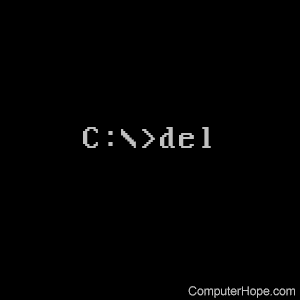Del command

The del command is used delete files from a computer.
Availability
Del is an internal command and is available in the following Microsoft operating systems.
- All versions of MS-DOS
- Windows 95
- Windows 98
- Windows Me
- Windows NT
- Windows 2000
- Windows XP
- Windows Vista
- Windows 7
- Windows 8
- Windows 10
- Windows 11
The delete command is a Recovery Console command and is available in the following Microsoft operating systems.
Del syntax
Windows 2000, Windows XP, and later syntax
Deletes one or more files.
DEL [/P] [/F] [/S] [/Q] [/A[[:]attributes]] names ERASE [/P] [/F] [/S] [/Q] [/A[[:]attributes]] names
| names | Specifies a list of one or more files or directories. Wildcards can delete multiple files. If a directory is specified, all files in the directory are deleted. |
| /P | Prompts for confirmation before deleting each file. |
| /F | Force deleting of read-only files. |
| /S | Delete specified files from all subdirectories. |
| /Q | Quiet mode, do not ask if ok to delete on global wildcard. |
| /A | Selects files to delete based on attributes. |
| attributes | R = Read-only files S = System files H = Hidden files A = Files ready for archiving - = Prefix meaning not (e.g., -h for not hidden). |
If Command Extensions are enabled, DEL and ERASE change as follows:
- The display semantics of the /S switch are reversed in that it shows you only the files that are deleted, not the ones it could not find.
Windows 2000 and Windows XP Recovery Console syntax
Deletes one file.
DEL [drive:][path]file name DELETE [drive:][path]file name
| [drive:][path]file name | Specifies the file to delete. |
Delete only operates in the system directories of the current Windows installation, removable media, the root directory of any hard disk partition, or the local installation sources.
Del and delete do not support replaceable parameters (wildcards).
Windows 95, 98, and Me syntax
Deletes one or more files.
DEL [drive:][path]file name [/P] ERASE [drive:][path]file name [/P]
| [drive:][path]file name | Specifies the file(s) to delete. Specify multiple files using wildcards. |
| /P | Prompts for confirmation before deleting each file. |
Del examples
In Microsoft Windows, deleted items go to the Recycle Bin. Realize that deleting files from MS-DOS or the Windows command line does not send them to the Recycle Bin.
del test.tmp
Deletes the test.tmp in the current directory, if the file exists.
del c:\windows\test.tmp
Delete the c:\windows\test.tmp in the Windows directory if it exists.
del c:\windows\temp\*.*
The * (asterisks) is a wild character. *.* indicates you want to delete all files in the c:\windows\temp directory.
del c:\windows\temp\?est.tmp
The ? (question mark) is a single wild character for one letter. The use of this command in the above example would delete any file ending with "est.tmp," such as "pest.tmp" or "test.tmp."
